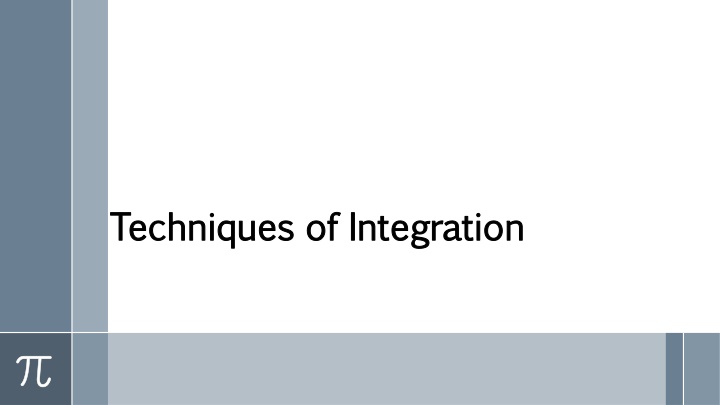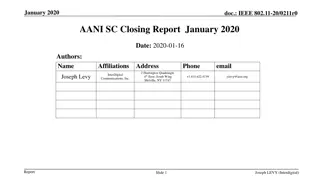
Techniques of Integration: Procedures and Examples for Matching Integrals
Explore various techniques of integration such as integration by parts, simplifying substitutions, completing the square, using trigonometric identities, eliminating square roots, and reducing improper fractions. The content includes detailed procedures and solved examples to help you understand and apply these integration techniques effectively.
Download Presentation

Please find below an Image/Link to download the presentation.
The content on the website is provided AS IS for your information and personal use only. It may not be sold, licensed, or shared on other websites without obtaining consent from the author. If you encounter any issues during the download, it is possible that the publisher has removed the file from their server.
You are allowed to download the files provided on this website for personal or commercial use, subject to the condition that they are used lawfully. All files are the property of their respective owners.
The content on the website is provided AS IS for your information and personal use only. It may not be sold, licensed, or shared on other websites without obtaining consent from the author.
E N D
Presentation Transcript
Techniques of Integration Techniques of Integration
Techniques of Integration Techniques of Integration Procedures for Matching Integrals to Basic Formulas Procedures for Matching Integrals to Basic Formulas Integration By Parts ( Integration By Parts (udv udv) ) Solved Solved Examples Examples
Procedures for Matching Integrals to Basic Formulas 1. Making a simplifying substitution Example 2? 9 ?2 9? + 1 ?? Sol. Let ? = ?2 9? + 1 then ?? = 2? 9 ?? 2? 9 ?2 9? + 1 ?? = ?? 1 2 ?? ?= ? 1 2+1 1 2 (?) ( 1 2+ 1) + ? =? 1 2 ?? = ? + ? = 2 ? + ? 1 2 2 ? + ? = 2 ?2 9? + 1 + ?
2. Completing the square Example ?? 8? ?2 Sol. We complete the square to simplify the denominator: 8? ?2= (?2 8?) = (?2 8? + 16 16) ?2 8? + 16 16 = ? 42 16 = 42 ? 42 ?? ?? 8? ?2= 42 ? 42 Let ? = ? 4 ??? ? = 4 ? ?? ?? = ?? ?? ?2 ?2= ??? 1? ?? 42 ? 42= + ? ? 8? ?2= ??? 1? 4 ?? + ? 4
3. Using a trigonometric identity Example sec? + tan?2?? Sol. We expand the integrand and get sec? + tan?2= ???2? + 2sec?tan? + ???2? The first two terms on the right-hand side of this equation are familiar; we can integrate them at once, but what about ???2? ??. There is an identity that connects it with ???2? . ???2? + 1 = ???2? ?? ???2? = ???2? 1 Then sec? + tan?2?? = (???2? + 2sec? tan? + ???2?)?? = (???2? + 2sec?tan? + ???2? 1)?? = (2???2? + 2sec?tan? 1)?? (2???2? + 2sec?tan? 1)??
= 2???2? ?? + 2sec?tan??? 1?? sec? + tan?2?? = 2tan? + 2sec? ? + ? 4. Eliminating a square root Example ? 4 1 + cos4? ?? 0 Sol. We use the identity ???2? =1 + cos2? ?? 2???2? = 1 + cos2? 2 Let ? = 2? ? ??, 2???22? = 1 + cos4? ? 4 ? 4 ? 4 2???22? ?? = 2 ???22? ?? 1 + cos4? ?? = 0 0 0 ? 4 ? 4 2 ???22? ?? = 2 cos2? ?? 0 0
On 0,? 4 cos2? 0 then cos2? = cos2? ? 4 ? 4 2 cos2? ?? = 2cos2? ?? 0 2cos2? ?? =1 0 ? 4 ? 4 Let ? = 2?,?? = 2??, 0 2cos2? . 2?? 2 0 ? 4 ? 4 1 2 2 2cos2? . 2?? = 2 cos2? . 2?? 0 0 ? 2 ? 2 1 1 1 2(sin? 1 1 2 cos?. ?? = 2sin? = 2 sin0) = 2 (1 0) = 2 0 0 5. Reducing an improper fraction Example 3?2 7? 3? + 2 ?? Sol. The integrand is an improper fraction (degree of numerator greater than or equal to degree of denominator). To integrate it, we divide first, getting a quotient plus a remainder that is a proper fraction:
? 3 3?2 7? 3?2+ 2? 9? 9? 6 3? + 2 6 3?2 7? 3? + 2 6 = (? 3) + 3? + 2 3?2 7? 3? + 2 6 6 ?? = (? 3) + 3? + 2?? = (? 3)?? + 3? + 2?? (? 3)?? =?2 2 3? + ? 6 ?? ???????? ? ? ??????????? 3? + 2?? Let ? = 3? + 2,? ?? ?? = 3?? 3 2 3? + 2?? = 2?? = 2ln 3? + 2 + ? ?
3? + 2?? =?2 6 (? 3) + 2 3? + 2ln 3? + 2 + ? Note: Reducing an improper fraction by long division does not always lead to an expression we can integrate directly 6. Separating a fraction Example 3? + 2 1 ?2?? Sol. We first separate the integrand to get: 3? + 2 1 ?2?? = 3? ?? 1 ?2+ 2?? 1 ?2 3? ?? 1 ?2 To evaluate the integration Let ? = 1 ?2, ? ?? ?? = 2? ?? ?? ??? = 1 2 ??
1 2 ?? 3? ?? 1 ?2= 3 ? ?? 1 ?2= 3 3 2 ? 1 2?? = ? ? 1 2 1 2= 3 ? = 3 1 ?2+ ? 3 2 ? 1 2?? = 3 2 ?? 1 ?2= 2 ??? 1? + ? 2 3? + 2 1 ?2?? = 3 1 ?2+ 2 ??? 1? + ? 7. Multiplying by a form of 1 Example sec? ?? Sol. sec? + tan??? = sec2? + sec? tan? sec? ?? = sec?sec? + tan? ?? sec? + tan?
Let ? = tan? + sec? ??? ?? = (sec2? + sec?tan?)?? (sec2? + sec? tan?) ?? = ?? ?= ln ? + ? tan? + sec? ln ? + ? = ln tan? + sec? + ? Integration By Parts (udv) Product Rule in Integral Form If and g are differentiable functions of x, the Product Rule says: ? ??? ? ? ? In terms of indefinite integrals, this equation becomes = ? ? ? ? + ? ? ? ? ? ??? ? ? ? ?? = ? ? ? ? ?? + ? ? ? ? ?? Rearranging the terms ? ? ? ? ?? = ? ??? ? ? ? ?? ? ? ? ? ?? Leading to the integration by parts formula ? ? ? ? ?? = ? ? ? ? ? ? ? ? ??
Sometimes it is easier to remember the formula if we write it in differential form. Let ? = ? ? ??? ,? = ? ? ? ?? ?? = ? ? ??, ?? = ? (?)?? Using the Substitution Rule, the integration by parts formula becomes ??? = ?? ??? This formula expresses one integral, ??? in terms of a second integral, ???. With a proper choice of u and v, the second integral may be easier to evaluate than the first. Example ? cos? ?? Sol. Using the integration by parts Let ? = ? ,?? = ?? ??? ?? = cos??? ? ?? ? = cos? ?? = sin? ? cos? ?? = ??? ??? = ?? ??? = ? sin? sin? ??
? cos? ?? = ? sin? + cos? + ? Example ln? ?? Sol. The integration can be written as ln? .1 ?? Let ? = ln? ,?? =1 ??? ,?? = 1?? ,? = ? ??? = ln? .1 ?? ??? = ?? ??? ln? .1 ?? = ?ln? ? ??? = ? ln? ? + ?
Example ?2???? Sol. Using integration by parts Let ? = ?2,?? = 2??? , ?? = ????, ? = ?? ??? = ?2???? ??? = ?? ??? ?2???? = ?2?? 2? ???? The new integral is less complicated than the original because the exponent on x is reduced by one. To evaluate the integral on the right, we integrate by parts again with ? ???? Let ? = ?,?? = ?? , ?? = ????, ? = ?? ? ???? = ??? ???? = ??? ??+ ?
?2???? = ?2?? 2? ???? = ?2?? 2 ??? ??+ ? ?2???? = ?2?? 2???+ 2??+ ? Example ??cos? ?? Sol. Using the integration by parts Let ? = ?? ??? ?? = cos? ?? ? ?? ?? = ???? ??? ? = sin? ??cos? ?? = ??sin? ??sin??? Now the integration ??sin? ?? will be evaluated again with udv formula. For ??sin??? let ? = ?? ??? ?? = sin? ?? ? ?? ?? = ???? ??? ? = cos?
??sin? ?? = ??cos? ??cos? ?? = ??cos? + ??cos??? ??cos??? = ??sin? ??sin??? = ??sin? [ ??cos? + ??cos???] ??cos? ?? = ??sin? + ??cos? ??cos??? Rearranging the equation ??cos? ?? + ??cos? ?? = ??sin? + ??cos? 2 ??cos? ?? = ??sin? + ??cos? ??cos? ?? =??sin? + ??cos? + ? 2











